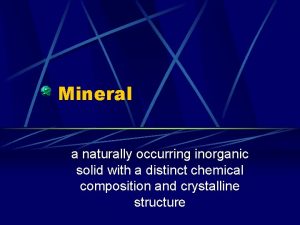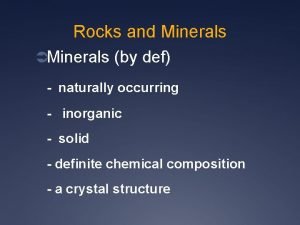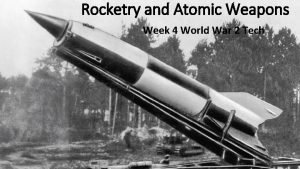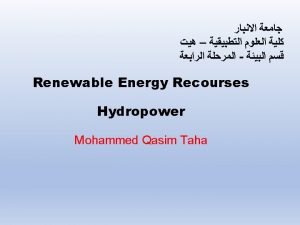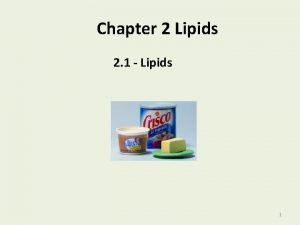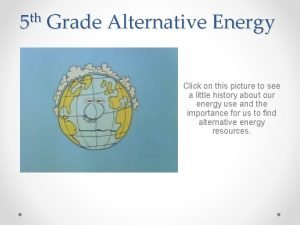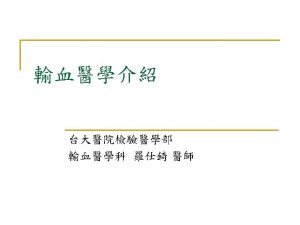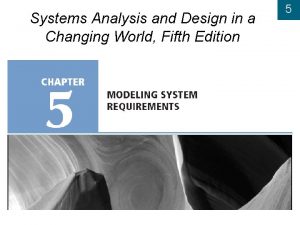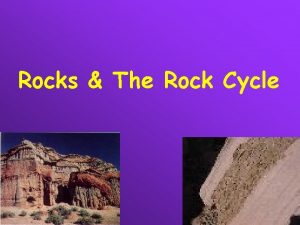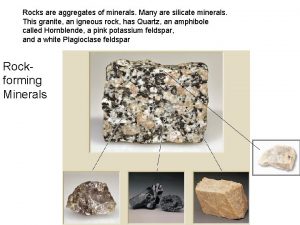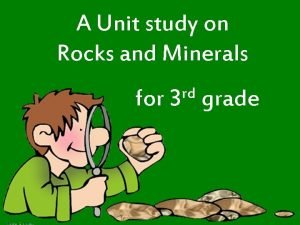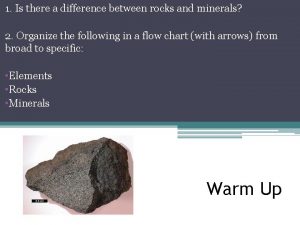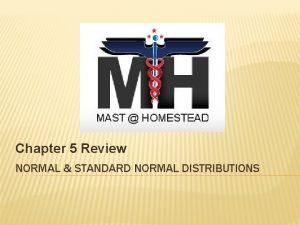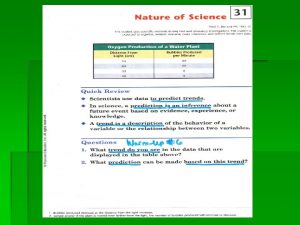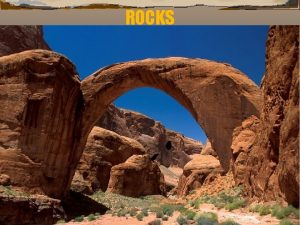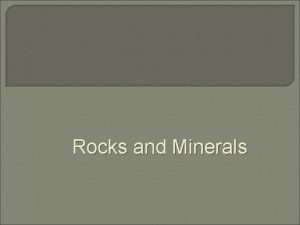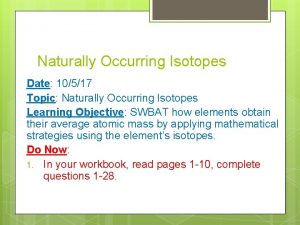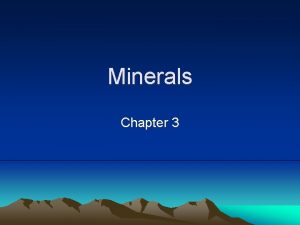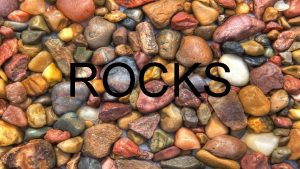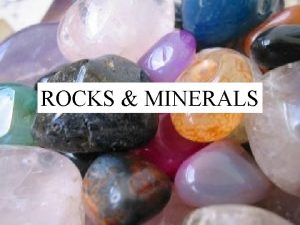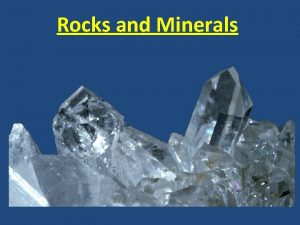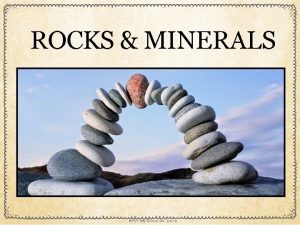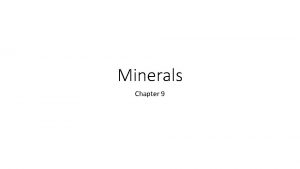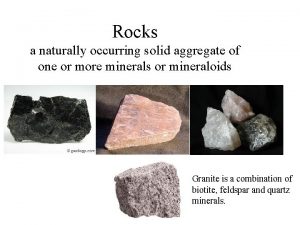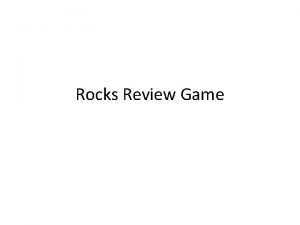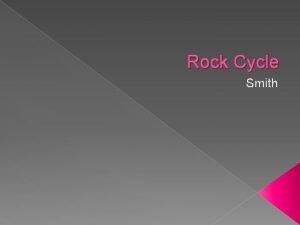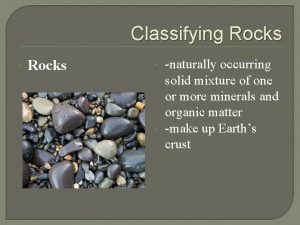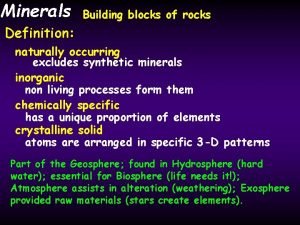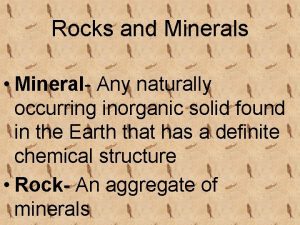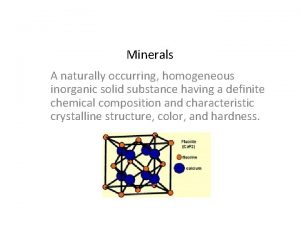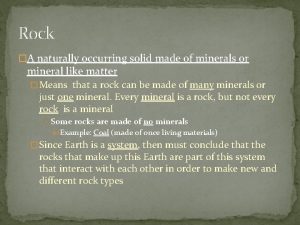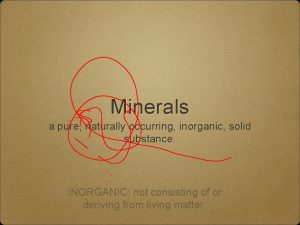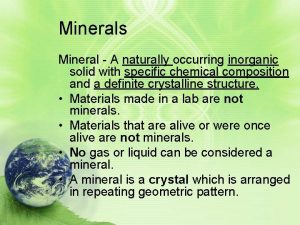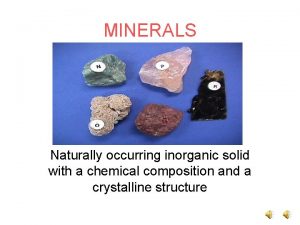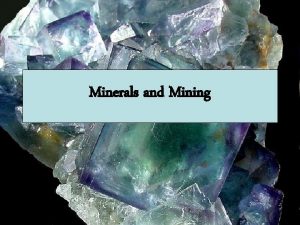Chapter 3 Minerals Rocks Minerals naturally occurring solid
























- Slides: 24

Chapter 3: Minerals & Rocks

Minerals naturally occurring , solid, crystalline, known physical & chemical properties building blocks of rocks over 2000 identified - few common

Common Mineral Groups silicates (98% of crust by weight) quartz feldspar - most common mica ferromagnesian clay (weathering product of other silicates) oxides - hematite, bauxite, magnetite carbonates - calcite sulfides - pyrite, often in coal - acid runoff native elements - gold, silver, copper, diamonds


Rocks solid aggregates of earth materials classification origin composition texture: size, shape, arrangement of grains

Igneous Rock from solidification of molten rock intrusive vs. extrusive composition mafic intermediate felsic

Igneous Activity – molten rock formation (melting) temp increases pressure decreases chemistry changes (ie. addition of water) rises due to lower density intrudes existing rock extrudes onto the surface

Igneous rock - intrusive magma texture cool slowly coarse grained intrusive bodies batholiths, plutons, laccoliths dikes & sills pipes & necks hydrothermal deposits rocks: granite, diorite, gabbro, peridotite

Igneous rocks - extrusive lava volcanoes textures cool quickly fine grained, glassy, vesicular rocks rhyolite, andesite, basalt obsidian, pumice tuff, volc breccia, bentonite

Igneous Rock Classification

Igneous Rocks – properties source of economic minerals economic rocks intrusive strong resistant to weathering resistant to fluid flow extrusive may be weak more susceptible to weathering less resistant to fluid flow

Sedimentary Rocks - formation weathering of rocks (produces sediment) physical – pieces of rock (clasts) chemical – clay & dissolved ions erosion & transportation deposition – accumulation of sediments clasts chemical precipitates organic material burial lithification

Sedimentary rocks - types clastic - detrital gravel, sand, silt, & clay non-clastic - chemical & biological limestone/dolostone – biological or chemical chert – biological (or post dep chem) evaporites – chemical (gypsum, rock salt) coal – biological


Sedimentary rocks – properties source of economic minerals economic rocks strength varies with sediment type cementation bedding plane weaknesses fluid flow varies with sediment type cementation subject to dissolution (esp. limestone) clay minerals: absorbent, expansive

Metamorphic Rocks - formation existing rock altered by heat • contact • hydrothermal pressure - fault zone heat & pressure • regional • impact foliation: alignment of platy or linear minerals due to pressure



Metamorphic rock types foliated: slate > phyllite > schist > gneiss non-foliated • • marble quartzite hornfels anthracite grade (degree of metamorphosis) type of foliation size of mineral crystals index minerals

Metamorphic rock – properties source of economic minerals economic rocks strength varies with foliation degree of metamorphism type of rock fluid flow is usually slow

The Rock Cycle shows how rocks form and how they relate to each other each rock type can be transformed into each of the others

Rock strength and deformation stress compression extension shear strain elastic - earthquakes plastic - folds brittle • joints • faults

Strength of Earth Materials rock type time temperature water content rock features/orientation stratification foliation intrusions

Rocks – the big picture Stratigraphy & petrology classification of rock units correlation of rock units Mapping formations (named rock units) structures orientation of layers allows planning
 Naturally occurring inorganic solid
Naturally occurring inorganic solid Igneous rocks metamorphic rocks and sedimentary rocks
Igneous rocks metamorphic rocks and sedimentary rocks Igneous metamorphic sedimentary
Igneous metamorphic sedimentary Naturally occurring mineral
Naturally occurring mineral Heaviest naturally occurring element
Heaviest naturally occurring element Advantages of biofuel
Advantages of biofuel Naturally occurring areas of hydrothermal resources
Naturally occurring areas of hydrothermal resources Largest naturally occurring element
Largest naturally occurring element Glycerol fatty acid
Glycerol fatty acid Naturally occurring areas of hydrothermal resources
Naturally occurring areas of hydrothermal resources Naturally occurring antibodies
Naturally occurring antibodies Is a naturally occurring association among specific things
Is a naturally occurring association among specific things Solid rock cycles
Solid rock cycles Rocks are aggregates of minerals
Rocks are aggregates of minerals Cementation rocks
Cementation rocks Rock cycle
Rock cycle Difference between rocks and minerals
Difference between rocks and minerals Concept map of rock cycle
Concept map of rock cycle Suzanna socked me sunday poem
Suzanna socked me sunday poem What kind of rock is this
What kind of rock is this Rocks and minerals
Rocks and minerals Extrusive rocks
Extrusive rocks Rhyolite vs basalt
Rhyolite vs basalt Find the probability of z occurring in the indicated region
Find the probability of z occurring in the indicated region What process is occurring
What process is occurring
